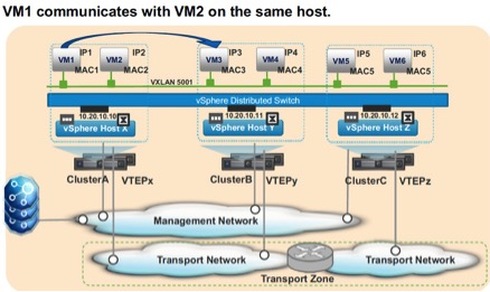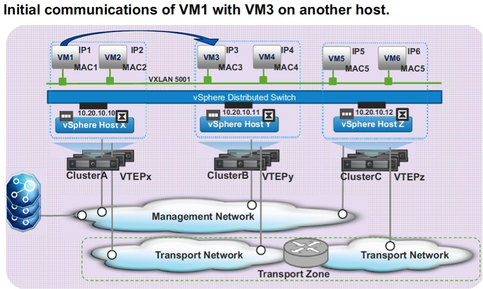Yeah, I am way behind on posting things. I passed the VCP6-NV exam last spring, since I have been working with NSX, and a bit of networking on a daily basis for a while I thought I would just schedule and take exam.
The exam is multiple choice, with several diagram questions, that have you select how a VM or host communicates with another VM or host. I think there were 4 or 5 questions on this. I also had a couple of questions on basic subnetting, so be sure and review that before you take the exam!
I watched two NSX courses from Pluralsight, www.pluralsight.com by Jason Nash. VMware NSX for vSphere Introduction and Installation and VMware NSX for vSphere: Network Services.
These are both a huge help in learning NSX, especially the details needed for many of the services it can provide.
I had several questions with a diagram, not as nice as the one below, asking how VM1 would find the Mac address, or IP address of VM2.
The exam is multiple choice, with several diagram questions, that have you select how a VM or host communicates with another VM or host. I think there were 4 or 5 questions on this. I also had a couple of questions on basic subnetting, so be sure and review that before you take the exam!
I watched two NSX courses from Pluralsight, www.pluralsight.com by Jason Nash. VMware NSX for vSphere Introduction and Installation and VMware NSX for vSphere: Network Services.
These are both a huge help in learning NSX, especially the details needed for many of the services it can provide.
I had several questions with a diagram, not as nice as the one below, asking how VM1 would find the Mac address, or IP address of VM2.
Here is the process if the VM’s are on the same host:
- VM1 sends Address Resolution Protocol (ARP) request for the MAC address of VM2 on the
same logical switch (VNI 5001) on the same host. - Broadcast is sent to all virtual machines on the logical switch of the same host. The switch
security module uses the management network to query the NSX Controller instances ARP
table for VM2 ARP entry. - Because VM2 is on the same logical switch, VM2 sends an ARP reply before NSX Controller
responds to the switch security module:- If VM2 has not participated in previous ARP reply or Dynamic Host Configuration Protocol (DHCP), the NSX Controller instance lacks the information.
- Switch security module updates local ARP table and notifies NSX Controller to update the ARP entry for VM2 (in the ARP table).
And the same but with the VM’s on different hosts:
The steps, for Unicast mode at least, are:
- VM1 sends an ARP request for the MAC address of VM3 on the same logical switch (VNI 5001) on a different host in a different cluster.
- Broadcast is sent on the local logical switch and the switch security module queries the NSX Controller instance for an ARP entry for VM3.
- The NSX Controller instance lacks the information on VM3. So the broadcast is forwarded as encapsulated unicast from VTEPx to all local VTEPs and the remote proxy VTEP.
- VM3 sends a unicast ARP reply that is encapsulated by VTEPy, and is sent to VTEPx, and returned to VM1.
- VTEPx learns the MAC address of VM3 for all subsequent communication from local virtual machines to VM3.
There were also a few questions on Distributed Switches, creating Port Groups ect.
I didn’t find the exam overly difficult, but with 85 or so questions I was pretty worn out at the end of the exam….
Good luck to everyone who is working towards this certification!!
I didn’t find the exam overly difficult, but with 85 or so questions I was pretty worn out at the end of the exam….
Good luck to everyone who is working towards this certification!!



 RSS Feed
RSS Feed